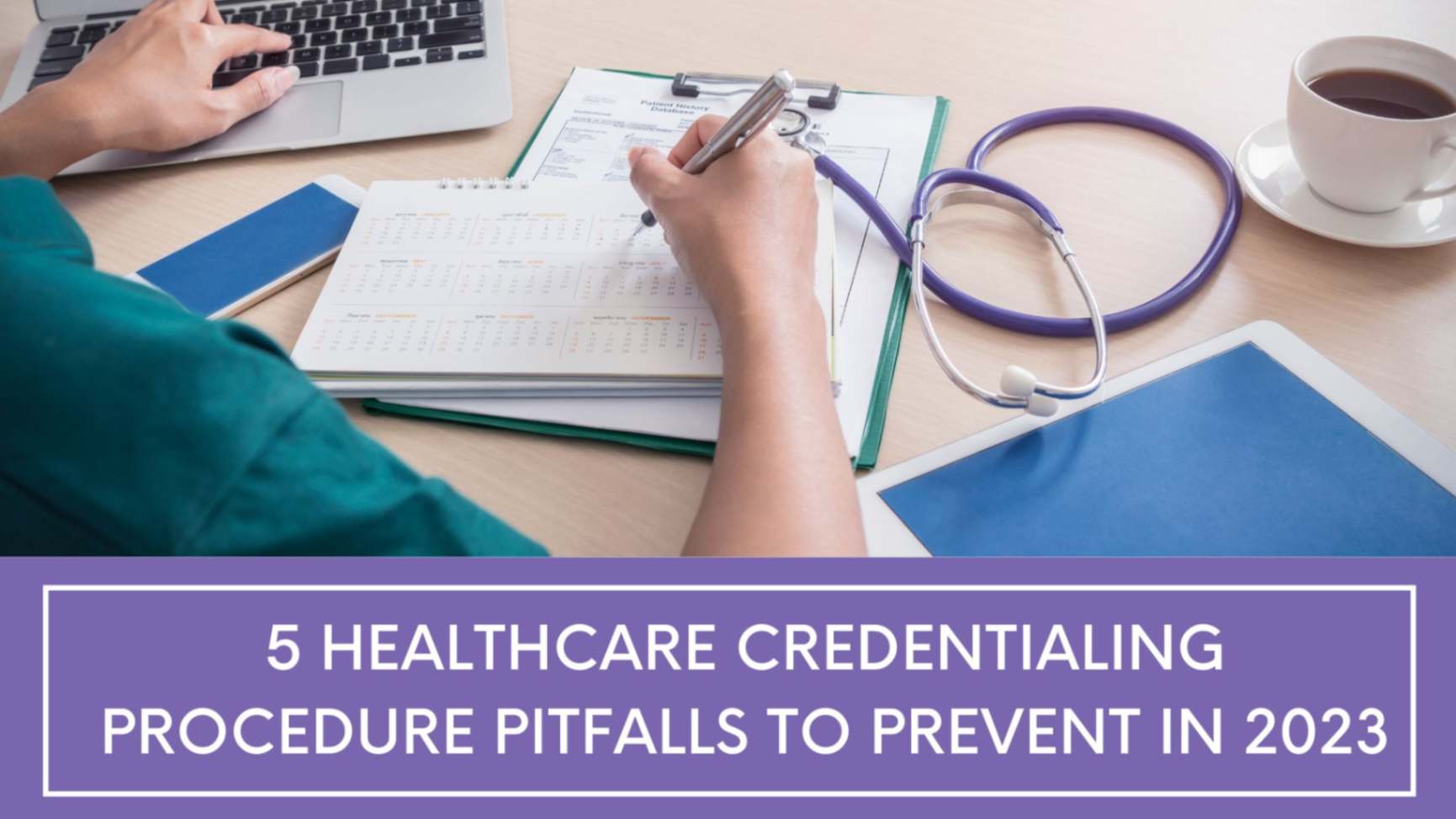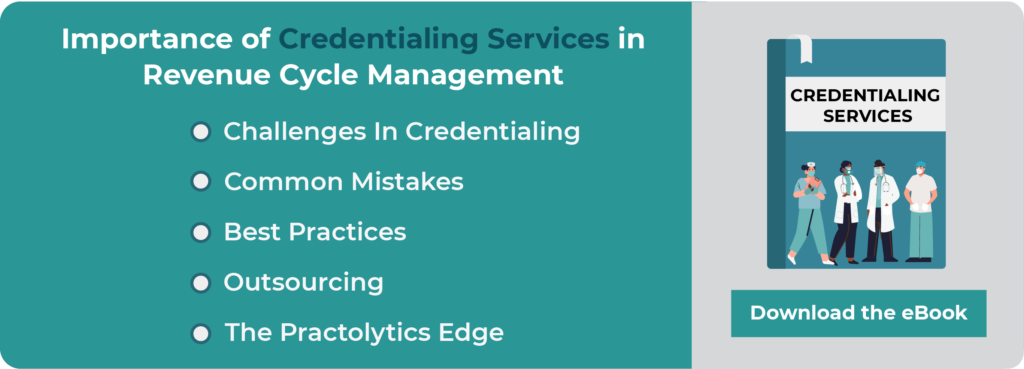5 Healthcare Credentialing Procedure Pitfalls to Prevent in 2023
The healthcare credentialing process is extremely resource hungry, and labour-intensive. It isn’t something professionals do just once and forget, like physical activity. It is a requirement in your medical practice, regardless of the extent of the operation, which demands constant attention.
Healthcare credentialing is necessary for practitioners, nurses, medical assistants, & therapists. Generally, everyone who works with patients must undergo the process of validating their credentials.
There are several credentialing procedure mistakes to avoid, & if they are not avoided, they can have a negative impact on your business, like income loss and, lawsuits in the worst situations.
Doesn’t that sound simple? So, what’s all the fuss about?
Table of Contents
Necessity of Credentialing In Healthcare RCM
Credentialing mistakes result in lost revenue, such as delayed claim payments, fines, and annulments from federally funded programmes. In the most unlikely scenario, it might result in patient harm & negligence litigation. This isn’t a fear tactic, but rather a realistic possibility.
A patient could have been saved When it was determined that an operative practitioner had not finished his twelve-month podiatric surgery residency. In addition, he lacks board certification. The physician caused damage that necessitated amputating the patient’s foot, resulting in an $8 million lawsuit. With the proper credentials, this hardship could’ve been avoided.
Even though it is legally required, credentialing has several benefits for your organization, especially in terms of future expansion. Your visibility to new clients in your region increases if you are accepted and listed among the health insurers’ in-network sources.
Patients will choose to go with clinics that are accepted by their particular insurance providers, which not only fosters trust in your practice but also promotes it.
Pitfalls In The Healthcare Credentialing Procedure To Avoid
The healthcare insurance credentialing procedure can take up to 60 – 90 days, with yet another 1 month likely for the contracting process. Medicare enrollment requires an average of 41 days. Any errors in the application, any absence of follow-up, or missed paperwork might prolong the procedure even further.
Over the past ten years, we have learned about several traps that keep clients from obtaining effective and timely credentialing. Let’s say you choose to tackle this unpleasant undertaking on your own. In that scenario, we urge you to focus on avoiding the key pitfalls in the healthcare credentialing procedure.
1. Know the laws/regulations in your state
The most crucial thing to know about healthcare credentialing is that there isn’t an all-around solution. All states have distinctive regulations surrounding credentialing, therefore it is important to know everything your state demands. Some states maintain reciprocal agreements, meaning that credentialing in one state is accepted in another. This isn’t the situation everywhere. You can save yourself a lot of time if you figured it out beforehand before beginning the procedure.
Each state has distinct criteria for various medical fields. Chiropractors, for example, are required across all states to clear particular state tests, NBCE exams, or even both. Homeopathic physicians, for instance, are licensed only in 17 states.
Professionals who provide services with knowledge in this industry can save your organization time and money by researching the specific state regulations and standards, in addition to what agreements are all in existence.
2. Compile all documents
The credentialing procedure will be delayed if the documentation in the Council of Affordable Quality Healthcare (CAQH) system is not accurate. According to research, 85% of software contains some kind of information problem, such as incorrect, missing, or out-of-date data.
When gathering data for the very first time, pay close attention. It will expedite the procedure and also save both time and energy in the long term. You really do not want needless delays driven on by providing inaccurate data because state healthcare credentialing can take up to 90 to 150 days.
Each employee in your clinic who is responsible for patient care should undergo the procedure. Every person is expected to provide information about their educational background, job experience, training, credentials, place of residence, and licenses. In some cases, certifications like CPR or RBT are also necessary. Knowing the state standards, the very first step noted above, is crucial to understand because the documentation requirements vary from a state-to-state.
3. Submit the application
Based on the clinic or insurer network, a pre-application is necessary. This screening process includes a background check in order to be exempt from hiring medical workers who do not meet the requirements for healthcare credentialing. The attention is on criminal histories & punitive measures, records of suspension or expulsion, and board certificates.
After completing the pre-application procedure, you are now all set to submit every essential information. Remember, you must complete this correctly on the very first try to avoid delays. The lengthier the healthcare credentialing procedure takes, more longer it will take for the treatment/services to be charged/ billed.
It is a healthcare credentialing checklist which could assist you in ticking every single box during the credentialing procedure. Here is a checklist to ensure a smooth credentialing process:
- Documentation and educational qualifications.
- Present healthcare license, DEA clearance, & state board certification are also all required.
- Professional experience.
- Individual immunization records.
- Personal medical record.
- References, both personal and professional.
- Justification of any breaks in job history.
- Hospital privileges and affiliations.
- Enrollment with CAQH.
- Recommendation letters.
- Your resume copy.
4. Remember to check on the status of the application
It is crucial that you follow up as quickly as possible after submitting the application. This is done to confirm that now the application is in process and that nothing is missing. There have been reports of insurance firms failing to notify individuals about problems in their applications, further delaying an already lengthy procedure.
5. Know your deadlines & plan accordingly
Unfortunately, health insurer credentialing has always been known to take a minimum of six months. As previously stated, certain insurance companies need credentialing before allowing payor contracts or reimbursements. Knowing the specific information surrounding the issue of the insurance firms’ effective dates can go a long way toward managing future cash flows.
Conclusion: Outsource to a skilled Team/Company to prevent these pitfalls
You’ve definitely figured out by now what we meant when we stated credentialing is a time-consuming procedure. It is a mind-numbing procedure with several pitfalls that might result in a future loss of time and cash.
The ideal approach would be to outsource this procedure to a respected professional business that specialises in medical credentialing services. Practolytics offers committed employees with extensive expertise who deal with these time-hungry operations on a regular basis, allowing you and your staff to concentrate on more key problems inside your organisation while also reducing the healthcare credentialing process.
Contact our Practolytics professionals by calling us at: +(803) 932-9624 (or) +(678) 940-8115.
ALSO READ – 5 Strategies for Accelerating Payor Enrollment Credentialing
Talk to Medical Billing Expert Today — Get a Free Demo Now!






